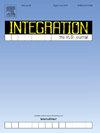An electronically controllable floating capacitor multiplier for low frequency applications
IF 2.5
3区 工程技术
Q3 COMPUTER SCIENCE, HARDWARE & ARCHITECTURE
引用次数: 0
Abstract
In this study, a floating capacitor multiplier structure without any passive resistor, created using a subtractor and a multiple-output current differencing transconductance amplifier (MO-CDTA), is extensively analyzed. In this respect, the characteristic equations, operating principles, and filter applications of the structure examined are provided. For the floating capacitor multiplier structure, multiplication factor ‘k’ varies between 400 and 1200 depending on the voltage. Besides the tunability feature, another striking aspect of this work is the applied of three different filter structures due to the floating configuration. The cut-off frequency of the low-pass filter created with the floating capacitor multiplier ranges from 12.5 kHz to 32.6 kHz. Another application, the high-pass filter, has a cut-off frequency ranging from 58.4 kHz to 207.3 kHz. In the final band-pass filter structure applied in this study, it is demonstrated that the center frequency of filter ranging from 15.5 kHz to 33.5 kHz is suitable for low frequency operations due to the structure's tunable feature. In addition to filter applications, post-layout details including temperature, Monte Carlo, and total harmonic distortion analysis of the proposed capacitor multiplier are provided alongside the experimental results.
一种用于低频应用的电子可控浮动电容倍增器
在本研究中,广泛分析了一种使用减法器和多输出差动跨导放大器(MO-CDTA)创建的无源电阻浮电容乘法器结构。在这方面,提供了特征方程,工作原理,并审查了结构的过滤器应用。对于浮动电容倍增器结构,倍增系数k根据VGS电压在400到1200之间变化。除了可调性之外,这项工作的另一个引人注目的方面是由于浮动配置而应用了三种不同的滤波器结构。使用浮动电容乘法器创建的低通滤波器的截止频率范围从12.5 kHz到32.6 kHz。另一个应用,高通滤波器,截止频率范围从58.4 kHz到207.3 kHz。在本研究最终采用的带通滤波器结构中,由于该结构的可调谐特性,证明了滤波器的中心频率在15.5 kHz ~ 33.5 kHz范围内适合低频工作。除滤波器应用外,还提供了实验结果的后布局细节,包括所提议的电容器乘法器的温度,蒙特卡罗和总谐波失真分析。
本文章由计算机程序翻译,如有差异,请以英文原文为准。
求助全文
约1分钟内获得全文
求助全文
来源期刊

Integration-The Vlsi Journal
工程技术-工程:电子与电气
CiteScore
3.80
自引率
5.30%
发文量
107
审稿时长
6 months
期刊介绍:
Integration''s aim is to cover every aspect of the VLSI area, with an emphasis on cross-fertilization between various fields of science, and the design, verification, test and applications of integrated circuits and systems, as well as closely related topics in process and device technologies. Individual issues will feature peer-reviewed tutorials and articles as well as reviews of recent publications. The intended coverage of the journal can be assessed by examining the following (non-exclusive) list of topics:
Specification methods and languages; Analog/Digital Integrated Circuits and Systems; VLSI architectures; Algorithms, methods and tools for modeling, simulation, synthesis and verification of integrated circuits and systems of any complexity; Embedded systems; High-level synthesis for VLSI systems; Logic synthesis and finite automata; Testing, design-for-test and test generation algorithms; Physical design; Formal verification; Algorithms implemented in VLSI systems; Systems engineering; Heterogeneous systems.
 求助内容:
求助内容: 应助结果提醒方式:
应助结果提醒方式:


